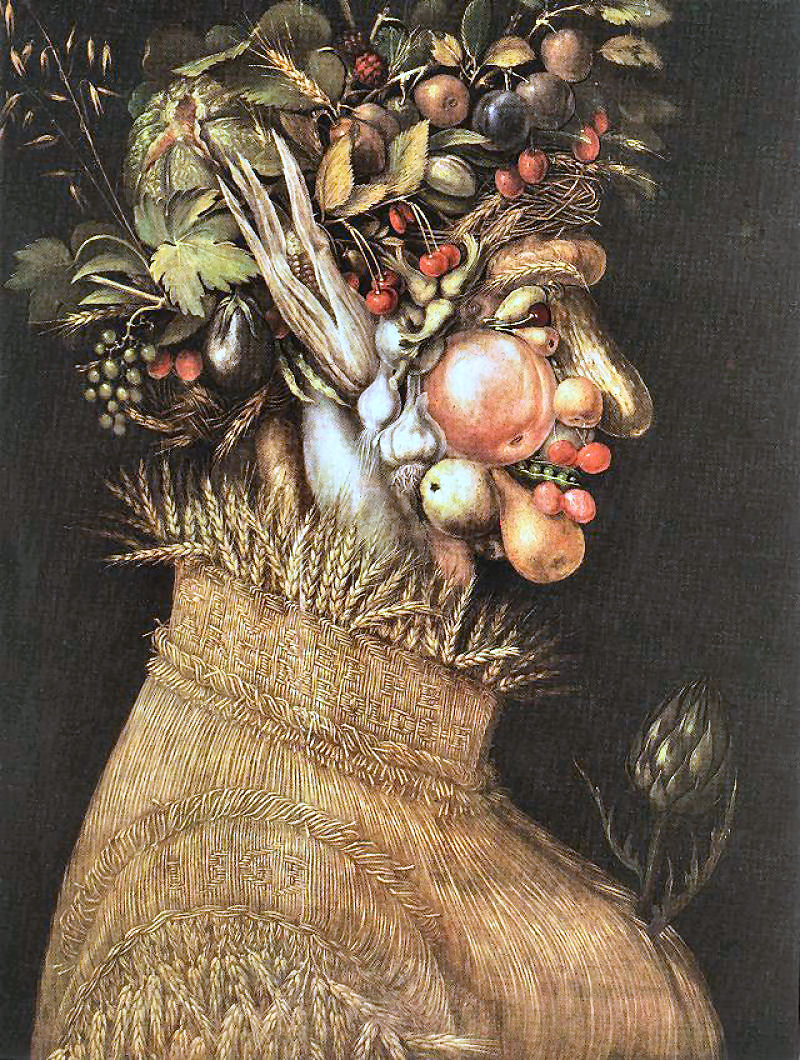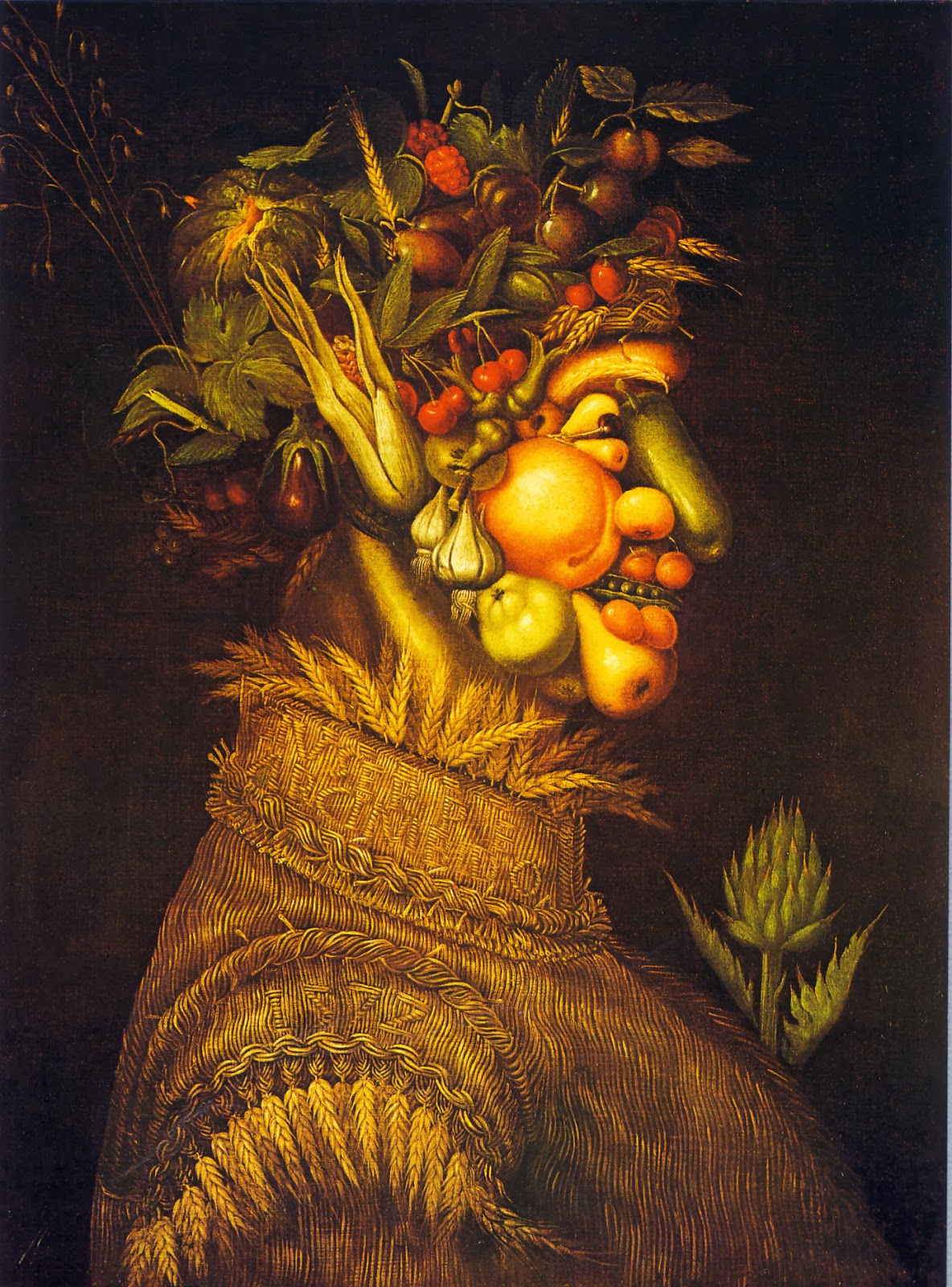
Giuseppe Arcimboldo e suas fantásticas pinturas Inclui "As Quatro
97 cm × 71 cm (38 in × 28 in) Location. Skokloster Castle. Accession. 11616. The Librarian is a painting in oils on canvas by the Italian artist Giuseppe Arcimboldo in the collection of Skokloster Castle in Sweden. It is thought to be a portrait of Wolfgang Lazius, a humanist and historian who served Holy Roman Emperors of the House of Habsburg.
PofessoraMaraPriscila RELEITURA GIUSEPPE ARCIMBOLDO (3º ANO MANHÃ)
The Four Elements is a series of four oil paintings by the Italian artist Giuseppe Arcimboldo which were created in 1566, during the Renaissance, for Maximilian II, Holy Roman Emperor.The paintings depict human faces in profile made up from different animals or objects. Air is represented by birds, Fire by burning wood and cannons, Earth by land animals and Water by marine creatures.

Giuseppe Arcimboldo MDig
Italian Painter Born: c.1527 - Milan Died: July 11, 1593 - Milan Movements and Styles: Mannerism Giuseppe Arcimboldo Summary Accomplishments Important Art Biography Influences and Connections Useful Resources Similar Art and Related Pages "Arcimboldo was recognised as an ingenious talent in his age, but he is much more famous in ours." 1 of 4
PofessoraMaraPriscila RELEITURA GIUSEPPE ARCIMBOLDO (3º ANO MANHÃ)
Giuseppe Arcimboldo was an Italian Renaissance painter known for his intricate paintings, which combined inanimate or found objects into a portrait that would resemble the portrait subject.

Vertumne Giuseppe Arcimboldo Giuseppe arcimboldo, Painting, Framed
The Milanese master Giuseppe Arcimboldo cemented his place in art history when, in the mid-16th century, he managed to fuse two of the most popular painting genres: portraiture and still life. His elaborate paintings of archetypes and allegorical figures made up of thematically appropriate objects—from a librarian made of books to a chef composed of food and cookware—remain as popular.

Giuseppe Arcimboldo (15271593) Tutt'Art Pittura * Scultura
Biography Vertumnus, a portrait depicting Rudolf II, Holy Roman Emperor, painted as Vertumnus, the Roman god of the seasons, c. 1590-91. Skokloster Castle, Sweden. Four Seasons in One Head, c. 1590, National Gallery of Art, U.S. Giuseppe's father, Biagio Arcimboldo, was an artist of Milan, Italy.

Curso TICs OBRAS DE GIUSEPPE ARCIMBOLDO RELEITURA DOS ALUNOS DO 4° ANO
Giuseppe Arcimboldo (Milão, 1527 — 11 de julho de 1593) foi um pintor italiano. Suas obras principais incluem a série "As quatro estações", onde usou, pela primeira vez, imagens da natureza, tais como frutas, verduras e flores, para compor fisionomias humanas.
PofessoraMaraPriscila RELEITURA GIUSEPPE ARCIMBOLDO (3º ANO MANHÃ)
Giuseppe Arcimboldo (born c. 1527, Milan [Italy]—died 1593, Milan) Italian Mannerist painter whose grotesque compositions of fruits, vegetables, animals, books, and other objects were arranged to resemble human portraits. In the 20th century these double images were greatly admired by Salvador Dali and other Surrealist painters.

Giuseppe Arcimboldo, Spring, 1563. to love many things Giuseppe
0:00 / 4:38 GIUSEPPE ARCIMBOLDO - RELEITURA COM RECORTE E COLAGEM Patricia Rocha 735 subscribers Subscribe 23 Share 1.1K views 2 years ago O VÍDEO FALA UM POUCO DO ARTISTA, MOSTRA ALGUMAS OBRAS.
-02-summer_giuseppe-arcimboldo(italian-1527-1593)__28686.1625195699.jpg?c=2)
The Four Seasons (Original Series) 02 Summer By Giuseppe Arcimboldo
Giuseppe Arcimboldo (1527 - 1593) was a painter best known for creating imaginative portrait heads made entirely of objects such as fruits, vegetables, flowers, fish, and books. He was a conventional court painter of portraits for three Holy Roman emperors in Vienna and Prague. He also painted religious subjects and, among other things, a.

alicenations Larissa Clause and the allegoric heads of Giuseppe Arcimboldo
Giuseppe Arcimboldo | Study of a Figure in a Niche (Saint Ambrose; recto); Architectural Studies: Four Alternative Designs for Fictive Niches and an Unrelated Design with Garlands (verso), ca. 1560-67 | The Metropolitan Museum of Art
PofessoraMaraPriscila RELEITURA GIUSEPPE ARCIMBOLDO (3º ANO MANHÃ)
A ripe pear, for instance, looks suddenly unappetizing once it's made to serve as a chin. At the National Gallery's "Arcimboldo, 1526-1593: Nature and Fantasy" it's easy enough to see.

Subiektywne opisy obrazów Giuseppe Arcimboldo Lato
October 1, 2020 10:53am Giuseppe Arcimboldo, Summer, 1563, oil on panel. Wikimedia Commons Few artists have painted portraits so beguiling as Giuseppe Arcimboldo, an Italian painter of the.

Giuseppe Arcimboldo Allegories of the Seasons, 1573 Tutt'Art
Giuseppe Arcimboldo [jew-SEP-pay arch-im-BOLD-OH] was born to a distinguished family in Milan, Italy, and began working as an artist at the Milan Cathedral, creating stained glass, fabrics, and paintings. His father, a painter, probably provided his early training. As the official artist and Master of Festivals for three successive German.
parede Luta Um bom amigo obra de arte de giuseppe arcimboldo vincular
Within a decade, Arcimboldo had made the jump from lighthearted whimsy to outlandish weirdness, with the first known composite heads presented to Maximilian on New Year's Day 1569. In 1590, Giuseppe Arcimboldo painted his royal patron, the Holy Roman Emperor Rudolf II, as a heap of fruits and vegetables. In any normal position severe.

Giuseppe Arcimboldo, the Renaissance Artist Whose FruitFaced Portraits
Yet, in 1590, Giuseppe Arcimboldo painted his royal patron, the Holy Roman Emperor Rudolf II, as a heap of fruits and vegetables (opposite). With pea pod eyelids and a gourd for a forehead, he.